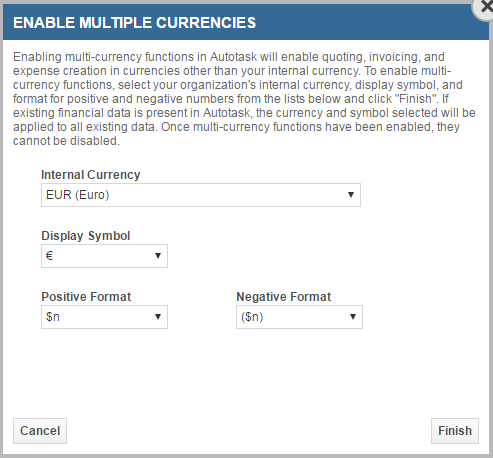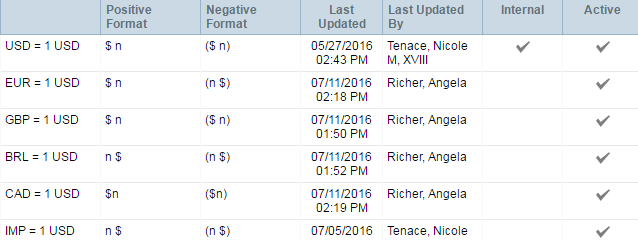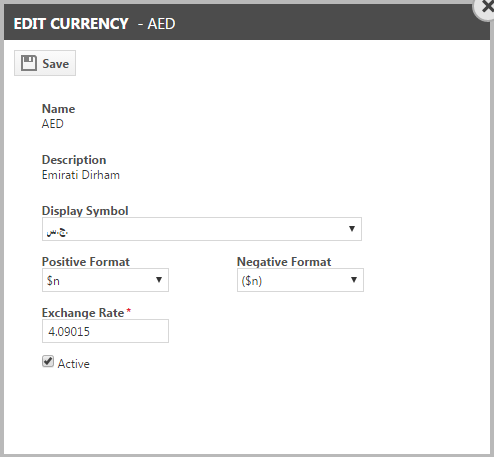Enabling Multi-currency and managing currencies
PERMISSIONS Security level with Admin permission to configure Finance, Accounting, & Invoicing. Refer to Admin security settings.
NAVIGATION Left Navigation Menu > Admin > Admin Categories > Features & Settings > Finance, Accounting & Invoicing > Currencies
The Multi-currency feature is initially disabled for all customers, and the Currencies page is not available. If you would like to have the Multi-currency module installed for your Autotask instance, please contact your Account Manager.
Once the module is installed, you can enable Multi-currency, select your internal currency, and activate any additional currencies you need.
How to...
Once the module is installed, do the following:
- To open the page, use the path(s) in the Security and navigation section above.
The Currencies page is now available, but no currencies are displayed.
- Click Enable Multiple Currencies. A dialog will open.
- Select your organization's Internal Currency.
- Click the Display Symbol drop-down menu and select an option. Note that you can select a blank option for your internal currency. If you select the blank option, a currency symbol is displayed for customer currencies, but not for your internal currency.
- Accept or select a positive and negative currency display format. For options, refer to Activate customer and vendor currencies and set exchange rates.
- Click Finish.
- Click Yes on the message that warns you that Multi-currency can never be disabled.
The page will refresh and now display all available currencies. The Enable Multiple Currencies button will change to Change Internal Currency.
- Activate any additional currencies that you require for your business. Refer to Activate customer and vendor currencies and set exchange rates.
NOTE For a list of all supported currencies and all symbols that can be used to display them, refer to Supported Currencies.
- Click Save.
IMPORTANT Once a currency other than the internal currency has been activated, you will no longer be able to select a different internal currency, and the Change Internal Currency button will be permanently disabled. Inactivating the second currency will not re-enable the button.
To activate and make changes to a currency setting (including the internal currency):
- On the Currencies page, click the Conversion Direction drop-down menu and select the conversion direction that makes the most sense to you.
NOTE Exchange rate values are saved in the Default (# [Internal Currency] = 1 unit other currency conversion direction. If you select the "Inverse" conversion direction, these values will be calculated by dividing 1 by the values entered. In this case, the saved values may vary slightly from the entered values, due to rounding.
- Hover over the context menu and select Edit.
The Edit Currency page opens.
- Edit the following fields:
- Click Save.
Autotask does not automatically set or update exchange rates. To keep them current, you have two options:
- You can update them manually
- You can use the Autotask API, where we have added Currency as a new entity and exposed the ExchangeRate field. Refer to Developer Help for SOAP API, REST API, ExecuteCommand API and Report Data Warehouse.
TIP BEST PRACTICE for customers who use exchange rates to determine prices in foreign currencies: If you do not want the ongoing hassle of setting specific prices in several foreign currencies, we recommend that you round your exchange rates up to a factor that will result in straightforward prices in all currencies. Example: Your internal currency is the Euro. 1 Pound = 1.19244 Euro. If you apply this exchange rate, prices in Pound will be hard to remember and hard to round. If you use an exchange rate of 1.25 or 1.30, not only will you factor in the costs of the currency exchange, but your foreign currency price lists will look more straightforward.
NOTE Note that the exchange rate is also used to calculate the internal price (that is, the revenue) on quotes and invoices, and the internal cost on purchase orders. While the exchange rate constantly fluctuates and your exchange rate setting on the Currencies page is hardly ever exactly correct, deviating too much from the actual exchange rate will throw off profitability calculations.
For directions on editing the exchange rate, refer to Exchange Rate.
Exchange rates and other currency settings are very important for customer billing. For this reason, Autotask makes an audit trail of changes made to a specific currency available in the Currency History window.
To open the Currency History window:
- On the context menu, select History.
The Currency History table opens. This table is read-only, but can be sorted in any column (except Detail) by clicking on the column header.
- Review the following columns:
| Column Name | Description |
|---|---|
| Date | Shows the date and time of the update. |
| Action | Shows the action that was performed. Options are: • Display Symbol changed • Exchange Rate changed • Currency changed from active to inactive • Currency changed from inactive to active • Positive Format changed • Negative Format changed |
| Detail | The Detail column shows changed from and changed to information. |
| Resource | Displays the name of the resource who initiated the update. |







